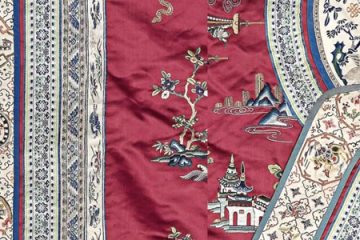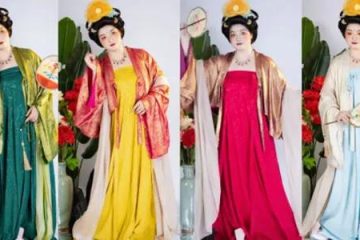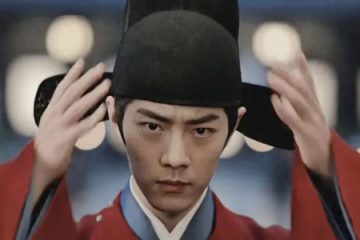Zhang Tian’ai Exudes Power in This Tang-Inspired Look!

In the historical drama The Litchi Road, actress Zhang Tian’ai appears as Lady Seventeen, stunning audiences in a Tang-style hanfu. As soon as she made her entrance, viewers took to the internet, exclaiming: “That look, that aura—she really brought the villainess to life!”
Ⅰ. The Striking “Tianbao Loose Hair” Look
Let’s start with the hairstyle. The Tang dynasty featured a vast and intricate system of hairdos, often characterized by what modern viewers might call “Head is larger than face”. The two hairstyles worn by Zhang Tian’ai in her appearances are highly recognizable styles from the High Tang period, especially the one shown in the image on the right, where her hair is worn down in long, flowing locks.
This particular look has been affectionately dubbed the “Tianbao Loose Hair” style by online fans, since it reflects the aesthetic seen in portraits of noblewomen from the mid-Kaiyuan to late Tianbao era.
Both of these hairstyles appear in the famous Dunhuang mural The Governor’s Wife Offering, specifically on the figures of the Eleventh Lady and the Thirteenth Lady. When compared to Zhang Tian’ai’s on-screen character, the resemblance is more than visual—it also seems to symbolically align with the historical references. The fact that both hairdos appear in the same mural also speaks to just how widespread and fashionable they were at the time.

Ⅱ. Hairstyle Details
Let’s start with the coiled bun style, which closely resembles the “Woduo Ji (倭堕髻)“—a hairstyle that was especially popular during the Kaiyuan era of the Tang dynasty.
It’s worth noting that the Kaiyuan era (713–741 CE) marked the height of the Tang dynasty’s golden age. This period was known for its stable governance, economic prosperity, and flourishing culture, and is often praised by later generations as the peak of Tang civilization—the “Kaiyuan Golden Age.”
During this time, Tang dynasty clothing, hairstyles, and art reached remarkable levels of refinement and aesthetic sophistication, setting enduring standards for elegance in Chinese history.
In this style, women would coil their hair into one or two buns on the top of the head, then allow sections of hair to fall loosely from one or both sides, creating a look somewhat similar to modern bangs or side-swept fringe. The overall shape is typically symmetrical, giving it a graceful and balanced appearance.

Let’s talk more about the so-called “Tianbao loose-hair” style. Despite the name, the hair wasn’t actually left hanging loose. Instead, it was first coiled into a bun and then arranged to fall down the back, giving the visual impression of loose hair.

Murals from the period show that this hairstyle typically featured a center part, with the hair falling symmetrically on both sides before being gathered and styled again at the back. Often, a topknot or decorative hairpiece such as a crown would be added to the top of the head to complete the look.
This “loose-hair” style also appeared in the historical drama The Longest Day in Chang’an. In that version, the character wore a lotus-shaped headdress, which, along with the flowing hair at the back, helped fill the visual space behind the head, creating a look that felt both formal and effortlessly relaxed.

Ⅲ. Styling Choices in the Drama
Compared to traditional loose-hair styles, Zhang Tian’ai’s look in the drama features a more voluminous and dramatic effect, thanks to the addition of a design element called “baomian” (抱面 in Chinese).
Literally meaning “Cheek-Hugging Hair,” baomian refers to hair that closely frames the cheeks. This effect was usually achieved by adding hair padding or sculpting the natural hair into specific shapes that wrapped around the sides of the face. According to the Treatise on the Five Elements in the New Book of Tang, “Toward the end of the Tang dynasty, women in the capital styled their hair to wrap closely around the cheeks.”
Later on, the term baomian came to refer more broadly to hair padding added to the three areas along the sides of the face, forming a fuller, face-framing silhouette that visually emphasized the shape of the head and face.

Of course, even during the Tang dynasty, it’s unlikely that most women had such voluminous natural hair, so these elaborate hairstyles were often not made from real hair. According to the Treatise on the Five Elements in the New Book of Tang, noblewomen of the time used false hairpieces, known as “yi ji” (义髻, literally “artificial buns”), as a key part of their adornment.
Tall and elaborate hair buns were highly fashionable during the Tang dynasty, and to achieve the desired height and shape, women used a wide variety of hair extensions and filler pieces. These “yi ji” could be made from animal hair, wooden slats, or even real human hair—sometimes collected from prisoners.

In classic Tang-style looks, women often adorned their foreheads with huadian (floral forehead decorations), drew arched “moon-shaped” brows, paired with delicately painted lips, and added a flush of rouge on both cheeks. Gold hairpins and ornamental combs were placed in the hair to complete the look—evoking the full grandeur of High Tang beauty.
It’s no surprise that viewers exclaimed, “I almost didn’t recognize her—is that really Zhang Tian’ai?”

These are just a few examples of the more distinctive Tang-inspired hairstyles. In fact, there were reportedly over a hundred variations of Tang hairdos. From where the bun was placed to how it was arranged, the combinations of shape, position, and accessories were incredibly diverse—an overwhelming display of creative styling.
Summer

Costume design in historical dramas has seen impressive improvements in recent years, with many viewers expressing their amazement: “This is exactly how Chinese traditional culture should be brought to the big screen!”
We look forward to seeing even more beautifully crafted Tang-style ensembles in the future—helping to share the elegance of traditional Chinese clothing with wider audiences.
If you found this interesting, feel free to like and share! Stay tuned for more insights and fun facts about Hanfu and traditional fashion.



0 Comments